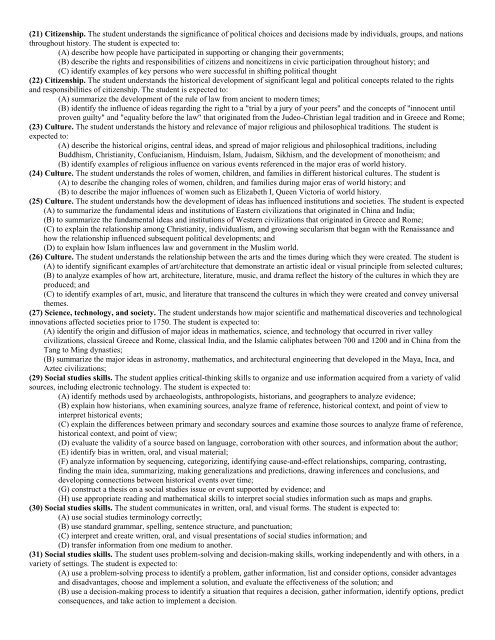Period 3 Regional and Transregional Interactions, c. 600 C.E. to c ...
Period 3 Regional and Transregional Interactions, c. 600 C.E. to c ...
Period 3 Regional and Transregional Interactions, c. 600 C.E. to c ...
Create successful ePaper yourself
Turn your PDF publications into a flip-book with our unique Google optimized e-Paper software.
(21) Citizenship. The student underst<strong>and</strong>s the significance of political choices <strong>and</strong> decisions made by individuals, groups, <strong>and</strong> nations<br />
throughout his<strong>to</strong>ry. The student is expected <strong>to</strong>:<br />
(A) describe how people have participated in supporting or changing their governments;<br />
(B) describe the rights <strong>and</strong> responsibilities of citizens <strong>and</strong> noncitizens in civic participation throughout his<strong>to</strong>ry; <strong>and</strong><br />
(C) identify examples of key persons who were successful in shifting political thought<br />
(22) Citizenship. The student underst<strong>and</strong>s the his<strong>to</strong>rical development of significant legal <strong>and</strong> political concepts related <strong>to</strong> the rights<br />
<strong>and</strong> responsibilities of citizenship. The student is expected <strong>to</strong>:<br />
(A) summarize the development of the rule of law from ancient <strong>to</strong> modern times;<br />
(B) identify the influence of ideas regarding the right <strong>to</strong> a "trial by a jury of your peers" <strong>and</strong> the concepts of "innocent until<br />
proven guilty" <strong>and</strong> "equality before the law" that originated from the Judeo-Christian legal tradition <strong>and</strong> in Greece <strong>and</strong> Rome;<br />
(23) Culture. The student underst<strong>and</strong>s the his<strong>to</strong>ry <strong>and</strong> relevance of major religious <strong>and</strong> philosophical traditions. The student is<br />
expected <strong>to</strong>:<br />
(A) describe the his<strong>to</strong>rical origins, central ideas, <strong>and</strong> spread of major religious <strong>and</strong> philosophical traditions, including<br />
Buddhism, Christianity, Confucianism, Hinduism, Islam, Judaism, Sikhism, <strong>and</strong> the development of monotheism; <strong>and</strong><br />
(B) identify examples of religious influence on various events referenced in the major eras of world his<strong>to</strong>ry.<br />
(24) Culture. The student underst<strong>and</strong>s the roles of women, children, <strong>and</strong> families in different his<strong>to</strong>rical cultures. The student is<br />
(A) <strong>to</strong> describe the changing roles of women, children, <strong>and</strong> families during major eras of world his<strong>to</strong>ry; <strong>and</strong><br />
(B) <strong>to</strong> describe the major influences of women such as Elizabeth I, Queen Vic<strong>to</strong>ria of world his<strong>to</strong>ry.<br />
(25) Culture. The student underst<strong>and</strong>s how the development of ideas has influenced institutions <strong>and</strong> societies. The student is expected<br />
(A) <strong>to</strong> summarize the fundamental ideas <strong>and</strong> institutions of Eastern civilizations that originated in China <strong>and</strong> India;<br />
(B) <strong>to</strong> summarize the fundamental ideas <strong>and</strong> institutions of Western civilizations that originated in Greece <strong>and</strong> Rome;<br />
(C) <strong>to</strong> explain the relationship among Christianity, individualism, <strong>and</strong> growing secularism that began with the Renaissance <strong>and</strong><br />
how the relationship influenced subsequent political developments; <strong>and</strong><br />
(D) <strong>to</strong> explain how Islam influences law <strong>and</strong> government in the Muslim world.<br />
(26) Culture. The student underst<strong>and</strong>s the relationship between the arts <strong>and</strong> the times during which they were created. The student is<br />
(A) <strong>to</strong> identify significant examples of art/architecture that demonstrate an artistic ideal or visual principle from selected cultures;<br />
(B) <strong>to</strong> analyze examples of how art, architecture, literature, music, <strong>and</strong> drama reflect the his<strong>to</strong>ry of the cultures in which they are<br />
produced; <strong>and</strong><br />
(C) <strong>to</strong> identify examples of art, music, <strong>and</strong> literature that transcend the cultures in which they were created <strong>and</strong> convey universal<br />
themes.<br />
(27) Science, technology, <strong>and</strong> society. The student underst<strong>and</strong>s how major scientific <strong>and</strong> mathematical discoveries <strong>and</strong> technological<br />
innovations affected societies prior <strong>to</strong> 1750. The student is expected <strong>to</strong>:<br />
(A) identify the origin <strong>and</strong> diffusion of major ideas in mathematics, science, <strong>and</strong> technology that occurred in river valley<br />
civilizations, classical Greece <strong>and</strong> Rome, classical India, <strong>and</strong> the Islamic caliphates between 700 <strong>and</strong> 1200 <strong>and</strong> in China from the<br />
Tang <strong>to</strong> Ming dynasties;<br />
(B) summarize the major ideas in astronomy, mathematics, <strong>and</strong> architectural engineering that developed in the Maya, Inca, <strong>and</strong><br />
Aztec civilizations;<br />
(29) Social studies skills. The student applies critical-thinking skills <strong>to</strong> organize <strong>and</strong> use information acquired from a variety of valid<br />
sources, including electronic technology. The student is expected <strong>to</strong>:<br />
(A) identify methods used by archaeologists, anthropologists, his<strong>to</strong>rians, <strong>and</strong> geographers <strong>to</strong> analyze evidence;<br />
(B) explain how his<strong>to</strong>rians, when examining sources, analyze frame of reference, his<strong>to</strong>rical context, <strong>and</strong> point of view <strong>to</strong><br />
interpret his<strong>to</strong>rical events;<br />
(C) explain the differences between primary <strong>and</strong> secondary sources <strong>and</strong> examine those sources <strong>to</strong> analyze frame of reference,<br />
his<strong>to</strong>rical context, <strong>and</strong> point of view;<br />
(D) evaluate the validity of a source based on language, corroboration with other sources, <strong>and</strong> information about the author;<br />
(E) identify bias in written, oral, <strong>and</strong> visual material;<br />
(F) analyze information by sequencing, categorizing, identifying cause-<strong>and</strong>-effect relationships, comparing, contrasting,<br />
finding the main idea, summarizing, making generalizations <strong>and</strong> predictions, drawing inferences <strong>and</strong> conclusions, <strong>and</strong><br />
developing connections between his<strong>to</strong>rical events over time;<br />
(G) construct a thesis on a social studies issue or event supported by evidence; <strong>and</strong><br />
(H) use appropriate reading <strong>and</strong> mathematical skills <strong>to</strong> interpret social studies information such as maps <strong>and</strong> graphs.<br />
(30) Social studies skills. The student communicates in written, oral, <strong>and</strong> visual forms. The student is expected <strong>to</strong>:<br />
(A) use social studies terminology correctly;<br />
(B) use st<strong>and</strong>ard grammar, spelling, sentence structure, <strong>and</strong> punctuation;<br />
(C) interpret <strong>and</strong> create written, oral, <strong>and</strong> visual presentations of social studies information; <strong>and</strong><br />
(D) transfer information from one medium <strong>to</strong> another.<br />
(31) Social studies skills. The student uses problem-solving <strong>and</strong> decision-making skills, working independently <strong>and</strong> with others, in a<br />
variety of settings. The student is expected <strong>to</strong>:<br />
(A) use a problem-solving process <strong>to</strong> identify a problem, gather information, list <strong>and</strong> consider options, consider advantages<br />
<strong>and</strong> disadvantages, choose <strong>and</strong> implement a solution, <strong>and</strong> evaluate the effectiveness of the solution; <strong>and</strong><br />
(B) use a decision-making process <strong>to</strong> identify a situation that requires a decision, gather information, identify options, predict<br />
consequences, <strong>and</strong> take action <strong>to</strong> implement a decision.


